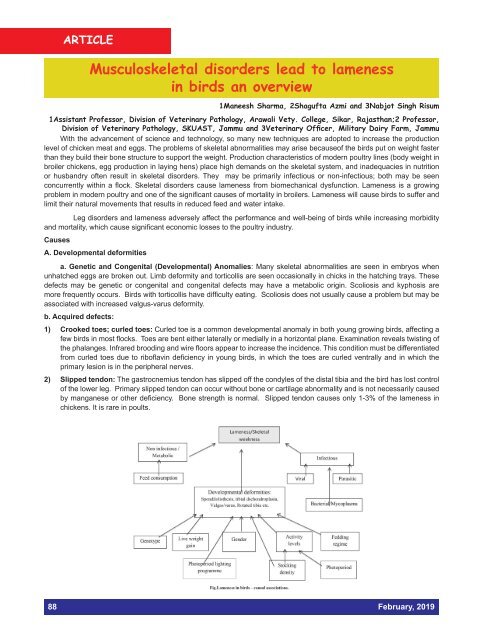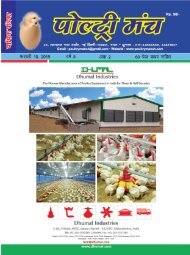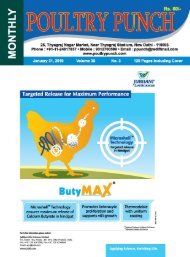POULTRY PUNCH - FEBRUARY 2019
POULTRY PUNCH - FEBRUARY 2019
POULTRY PUNCH - FEBRUARY 2019
- No tags were found...
You also want an ePaper? Increase the reach of your titles
YUMPU automatically turns print PDFs into web optimized ePapers that Google loves.
ARTICLE NEWS<br />
Musculoskeletal disorders lead to lameness<br />
in birds an overview<br />
1Maneesh Sharma, 2Shagufta Azmi and 3Nabjot Singh Risum<br />
1Assistant Professor, Division of Veterinary Pathology, Arawali Vety. College, Sikar, Rajasthan;2 Professor,<br />
Division of Veterinary Pathology, SKUAST, Jammu and 3Veterinary Officer, Military Dairy Farm, Jammu<br />
With the advancement of science and technology, so many new techniques are adopted to increase the production<br />
level of chicken meat and eggs. The problems of skeletal abnormalities may arise becauseof the birds put on weight faster<br />
than they build their bone structure to support the weight. Production characteristics of modern poultry lines (body weight in<br />
broiler chickens, egg production in laying hens) place high demands on the skeletal system, and inadequacies in nutrition<br />
or husbandry often result in skeletal disorders. They may be primarily infectious or non-infectious; both may be seen<br />
concurrently within a flock. Skeletal disorders cause lameness from biomechanical dysfunction. Lameness is a growing<br />
problem in modern poultry and one of the significant causes of mortality in broilers. Lameness will cause birds to suffer and<br />
limit their natural movements that results in reduced feed and water intake.<br />
Leg disorders and lameness adversely affect the performance and well-being of birds while increasing morbidity<br />
and mortality, which cause significant economic losses to the poultry industry.<br />
Causes<br />
A. Developmental deformities<br />
a. Genetic and Congenital (Developmental) Anomalies: Many skeletal abnormalities are seen in embryos when<br />
unhatched eggs are broken out. Limb deformity and torticollis are seen occasionally in chicks in the hatching trays. These<br />
defects may be genetic or congenital and congenital defects may have a metabolic origin. Scoliosis and kyphosis are<br />
more frequently occurs. Birds with torticollis have difficulty eating. Scoliosis does not usually cause a problem but may be<br />
associated with increased valgus-varus deformity.<br />
b. Acquired defects:<br />
1) Crooked toes; curled toes: Curled toe is a common developmental anomaly in both young growing birds, affecting a<br />
few birds in most flocks. Toes are bent either laterally or medially in a horizontal plane. Examination reveals twisting of<br />
the phalanges. Infrared brooding and wire floors appear to increase the incidence. This condition must be differentiated<br />
from curled toes due to riboflavin deficiency in young birds, in which the toes are curled ventrally and in which the<br />
primary lesion is in the peripheral nerves.<br />
2) Slipped tendon: The gastrocnemius tendon has slipped off the condyles of the distal tibia and the bird has lost control<br />
of the lower leg. Primary slipped tendon can occur without bone or cartilage abnormality and is not necessarily caused<br />
by manganese or other deficiency. Bone strength is normal. Slipped tendon causes only 1-3% of the lameness in<br />
chickens. It is rare in poults.<br />
88 February, <strong>2019</strong>






